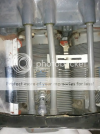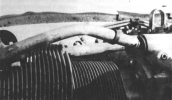FPK1
Line Up and Wait
My plane has the Lycoming IO-390 engine with G1000NXi PFD and MFD with engine details on the MFD engine page. It's pretty new, was put in service in January 2022, and currently has 247 hours...
Pretty much every cold start now (outside temp never below 50f) a few seconds after the EGT tempuratures start to display, the #2 EGT temperature drops off for a couple seconds (bar drops, temp # gauge goes blank), the engine runs rough, and then it comes back to normal. It's been like this for about 50 hours now.
Additionally, only twice, the #4 EGT dropped off briefly at start or when preparing for run-up. But mostly it's the #2 doing this.
Manual says RPMs at start/warm up should be between 1000-1200 and I usually have it in that range.
Never have the EGTs dropped off "during" a run-up.
Twice during a take off climb, the #2 EGT dropped off very briefly, the engine ran rough, then after a second or two, back to normal.
Once, 90 minutes into a flight from my home airport after a cold start, the #2 EGT dropped off and engine ran rough for almost 15 seconds, then back to normal. During that time an in air mag check was performed and it was still running rough on each mag and both. But it cleared to normal in about 15 seconds. A few minutes later while in a near idle descent the #4 EGT dropped off for about 2 seconds, then came back normal.
Mechanic did cold intake leak test (passed), cleaned fuel filter, fuel injectors and fuel spider. Swapped #2 spark plug with #3. Swapped fuel injector #2 with #4.
The #4 EGT dropped before and after the swap and #2 EGT continues to drop during every cold start (at my home airport) even after the swap. Before the swap #2 EGT always ran the hottest, now #4 EGT runs the hottest.
For the last year and a half, my fuel comes from my home airport fuel truck. All these cold start issues happened at that airport. Only use avgas 100LL.
Never had the issue with warm starts, like after a $100 hamburger day trip.
I never "noticed" this issue during a cold start following a flight where I stayed overnight at another airport, and where I have usually purchased at least 25 gallons of their fuel (tanks are 61 total usable).
I'm pretty good at leaning, in the air and on the ground.
Any thoughts and recommendations for me or my mechanic would be appreciated!
Pretty much every cold start now (outside temp never below 50f) a few seconds after the EGT tempuratures start to display, the #2 EGT temperature drops off for a couple seconds (bar drops, temp # gauge goes blank), the engine runs rough, and then it comes back to normal. It's been like this for about 50 hours now.
Additionally, only twice, the #4 EGT dropped off briefly at start or when preparing for run-up. But mostly it's the #2 doing this.
Manual says RPMs at start/warm up should be between 1000-1200 and I usually have it in that range.
Never have the EGTs dropped off "during" a run-up.
Twice during a take off climb, the #2 EGT dropped off very briefly, the engine ran rough, then after a second or two, back to normal.
Once, 90 minutes into a flight from my home airport after a cold start, the #2 EGT dropped off and engine ran rough for almost 15 seconds, then back to normal. During that time an in air mag check was performed and it was still running rough on each mag and both. But it cleared to normal in about 15 seconds. A few minutes later while in a near idle descent the #4 EGT dropped off for about 2 seconds, then came back normal.
Mechanic did cold intake leak test (passed), cleaned fuel filter, fuel injectors and fuel spider. Swapped #2 spark plug with #3. Swapped fuel injector #2 with #4.
The #4 EGT dropped before and after the swap and #2 EGT continues to drop during every cold start (at my home airport) even after the swap. Before the swap #2 EGT always ran the hottest, now #4 EGT runs the hottest.
For the last year and a half, my fuel comes from my home airport fuel truck. All these cold start issues happened at that airport. Only use avgas 100LL.
Never had the issue with warm starts, like after a $100 hamburger day trip.
I never "noticed" this issue during a cold start following a flight where I stayed overnight at another airport, and where I have usually purchased at least 25 gallons of their fuel (tanks are 61 total usable).
I'm pretty good at leaning, in the air and on the ground.
Any thoughts and recommendations for me or my mechanic would be appreciated!





